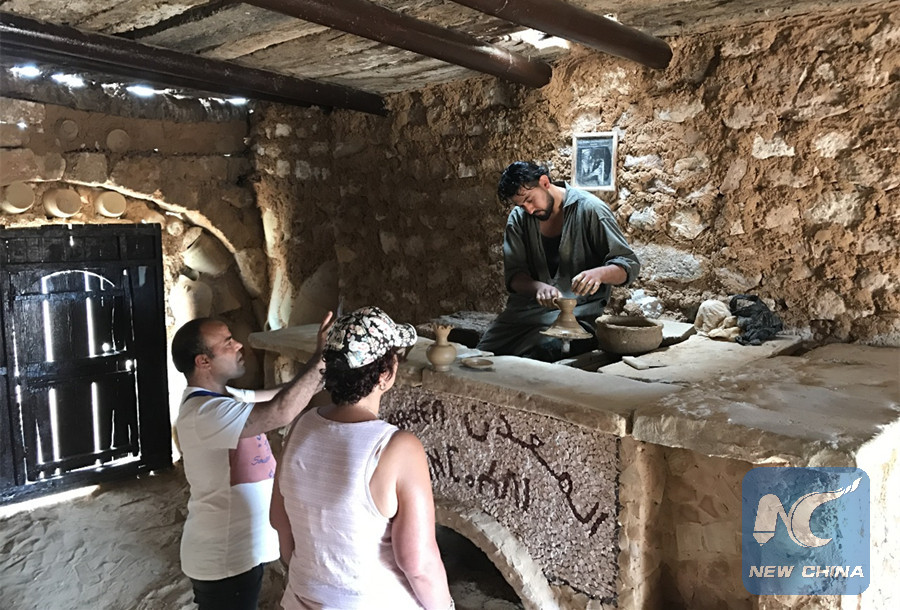
With a history of hundreds of years, Guellala village in the Mediterranean resort Djerba island in southern Tunisia is renowned for its traditional pottery industry. (Xinhua/Liu Kai)
TUNIS, June 2 (Xinhua) -- Clay taking shape in his hands, Tawfik Alkdhi was modeling pottery on a banding wheel in his family's workshop in Guellala village of the Mediterranean resort Djerba island in southern Tunisia.
Endowed with a mastery, this 28-year-old local potter managed to manually make a piece of pottery, later to be fired in a furnace.
"Our workshop has a history of hundreds of years and this is a quite ancient craft passed down for generations," said Alkdhi.
Guellala, a small village with another ancient name Haribus, was renowned for its traditional pottery industry. It's said the pottery art was introduced in Tunisia by the Phoenicians and Guellala village began to produce traditional pottery since Ancient Rome times.
Like Alkdhi's family, which consisted of 10 members, most inhabitants here were engaged in this ancient craft and mainly live on making pottery. The traditional pottery products in this village feature unglazed storage jars modeled on ancient amphora.
The clay used by the potters was excavated from 20 meters deep underground, broken up into pieces, mixed with water for four days and kneaded with feet.
"The underground of our village is full of clay," said Alkdhi. "There are always two pools in the yard. One is with fresh water for red-color pottery, and the other is with seawater for white-color."
Pottery takes shape on the potter's wheel, and get dried in the shade, small ones for one week and large ones for one month.
"Collections were taken to a big furnace, with palm tree branches as the fuel in the kiln, staying for 5-day-firing with 1,200 degrees Celsius," said Alkdhi. "Every month, we light the furnace once, for a large batch of pottery, and this is a big day, working with families together, like a celebration."
The ancient pottery craft has brought fame to this tiny village. On the main street, workshops with pottery artistically embedded into stone arches and houses were easily found to attract visitors. Local potters host a free demonstration of pottery making and explain the whole process of turning clay into a final product.
Melanie Safka, a tourist from New Zealand, said "it's quite impressive. Time seems to have stopped here. They work almost in the same way as old Romans did. What a great experience." In the show room, which presented a wide assortment of pottery for sale, Melanie bought one amphora as souvenir.
Alkdhi told Xinhua that as local tourism started to revive this year, he received tourists from different countries, such as Brazil, Japan, France and the United States.
"The work with clay should change with times. We don't just stick to the pottery of old types, we also change for innovation with modern types," said Alkdhi.
Ramzi Boussetta, the 35-year-old cousin of Alkdhi, also a local potter in Guellala, ran another workshop just on the opposite of the main street.
"I also learned the craft from my father, inherited for generations, just like many local families," said Boussetta. "This year, more European tourists come here."
Despite the current good business, Alkdhi said he was worried the pottery industry in his village would vanish in the future. "It's difficult work and there will not be many people willing to do this."
Boussetta was also not optimistic about the future of this local industry, saying "it will disappear. I have a daughter, but I don't want her to engage in this."
There were over 400 local potters living in this village in the past, "but nowadays many young men here don't want it, because it takes time and patience. Instead, they want to go to the outside world, do easier things for more money," said Alkdhi.
In his childhood, Alkdhi played around with clay and watched his father make pottery. When he turned 20, his father officially passed down the craft to him.
"I want to carry on this career, because this craft was the origin of my village," said Alkdhi. "I want the local pottery industry to stay in the future, this is my dream."

